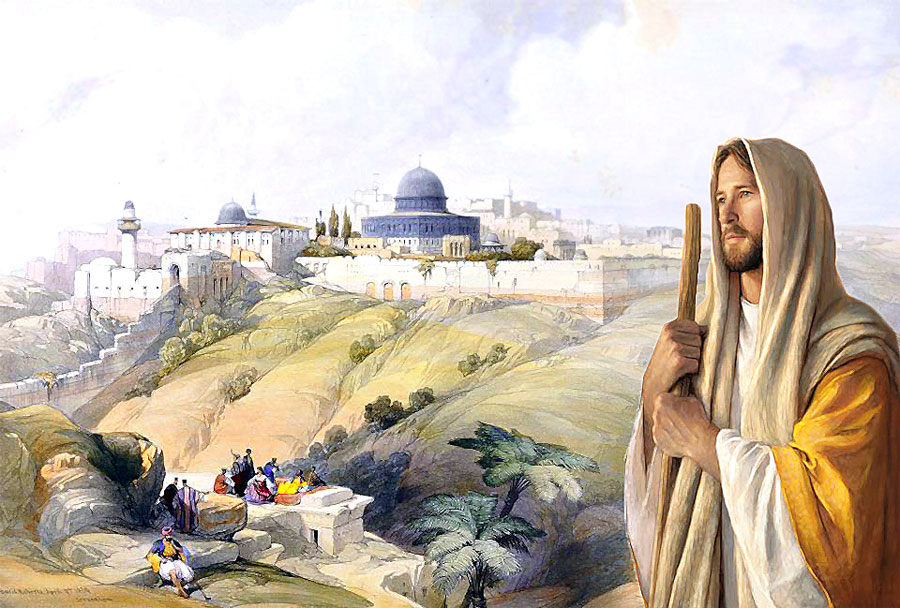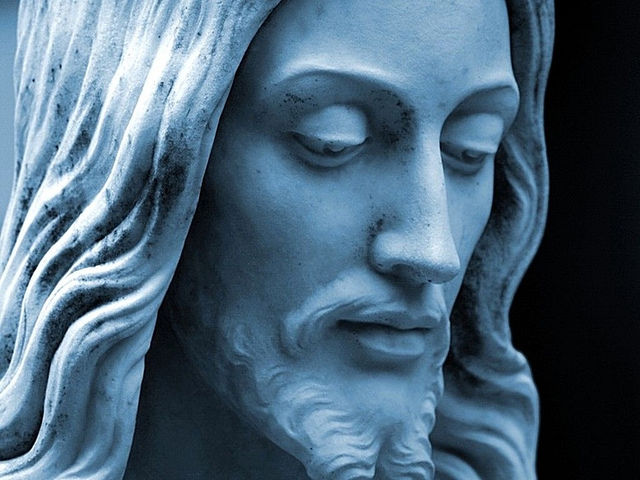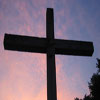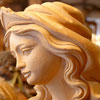Jesus And The Essenes
 by D.M. Hoover
by D.M. Hoover
The Essenes, as they came to be known, were said to have been formed around 500 B.C. when several masters of the priesthood formed a fraternity called Essaioli. According to early historians, such as Josephus, they lived peaceful disciplined and pious lives arising every morning before dawn for silent meditation and prayer. They were strict vegetarians who blessed everything they consumed before taking it into their bodies, for they revered all forms of life and this was a way in which they showed their respect. Their disciplined lifestyle devoid of all convenience and worldly possessions was a difficult one which required extreme devotion; consequently the number of people who chose to join remained relatively small throughout their history. Their dedication to focus solely on spiritual ideals is far different than the values most people, then and now, place on material attainment.
Much of what we know about the Essenes comes through actual historical records. Several contemporary writers documented their existence, lifestyle and customs all of which might be accurately described today as communal or socialistic in nature. The first century historian and scholar Flavious Josephus (37 CE – 100), speaking mainly of the sect located at Qumran described their lifestyle in The Jewish War Book II, Chapter 8 in this way:
“For three forms of philosophy are pursued among the Judeans: the members of one are Pharisees, of another Sadducees, and the third [school], who certainly are reputed to cultivate seriousness, are called Essenes; although Judeans by ancestry, they are even more mutually affectionate than the others. Whereas these men shun the pleasures as vice, they consider self-control and not succumbing to the passions virtue. And although there is among them a disdain for marriage, adopting the children of outsiders while they are still malleable enough for the lessons, they regard them as family and instill in them their principles of character.
“Since they are despisers of wealth—their communal stock is astonishing—, one cannot find a person among them who has more in terms of possessions. For by a law, those coming into the school must yield up their funds to the order, with the result that in all [their ranks] neither the humiliation of poverty nor the superiority of wealth is detectable, but the assets of each one have been mixed in together, as if they were brothers, to create one fund for all. They make it a point of honor to remain hard and dry, and to wear white always. Hand-elected are the curators of the communal affairs, and indivisible are they, each and every one, [in pursuing] their functions to the advantage of all.”
Edgar Cayce On The Essenes
“Then the King will say to those on his right, “Come, you who are blessed by my Father; take your inheritance, the kingdom prepared for you since the creation of the world. For I was hungry and you gave me something to eat, I was thirsty and you gave me something to drink, I was a stranger and you looked after me, I was in prison and you came to visit me”. [Matthew 25:34-36 NIV]
Was the statement above by Jesus part of an Essene doctrine that Josephus, Pliny and the others wrote about 2,000 years ago? This was indeed a group who cared for those in need. We learn from the Cayce readings that they had gateways in Bethany, in Galilee, and in Judea of ancient Palestine where those in need of assistance could seek and receive aid.
As early as 1936 while giving a prior life reading, Edgar Cayce described the Carmel Essene Community on the shores of the Dead Sea. They may well have been mentioned even earlier in his readings but unfortunately prior to the employment of Gladys Davis to transcribe and preserve the readings, many were lost. We owe Gladys Davis Turner a debt of gratitude for her diligence in compiling the vast library of readings, letters and notes housed in the A.R.E. today.
At the time when the scrolls of Qumran were initially found, there was no archaeological evidence that women and children were part of the community and the historical records were contradictory on the subject. But the Cayce readings while in trance state were quite clear and tell us that in some cases women took a very active role.
From reading #1283-1 in October 1936, Mr. Cayce tells us that #1283 had been a Prophetess in the Essene community. Obviously the term prophetess refers to a woman, and according to Cayce, men and women were equals within the organization.
On the 21st day of June, 1942, Mr. Cayce gave a reading for #1010 in which he outlined a prior life as a woman within the Carmel Essene community. In the reading he said her name had been Sophie or Josie and that she was a “handmaid to Mary, Jesus and Joseph, throughout the childhood of the Master”. He went on to say that Josie was one of the twelve maidens chosen by the community as an indication of their fitness.
The A.R.E. reported that in 1951 archaeologists discovered evidence of women living at the Qumran community. Prior to this discovery most scholars believed that the Essenes were a monastic community comprised strictly of men, and as pointed out earlier even the historical records were not in agreement on this point. The author found that in the main, Edgar Cayce spoke in his readings almost exclusively of the community in Carmel. It is certainly possible that other sects held to different rules and standards in the area of women within their groups.
It is possible that even in sects that allowed for woman and marriage that celibacy might have been encourage and held to be the preferred lifestyle.
Question: “Was the main purpose of the Essenes to raise up people who would be fit channels for the birth of the Messiah who later would be sent out into the world to represent their Brotherhood?”
Answer: “The individual preparation was the first purpose. The being sent out into the world was secondary. Only a few held to the idea of the realization in organization other than that which would come with the Messiah’s pronouncements”. [254-109]
I think it would be well to mention something at this point that anyone reading the Edgar Cayce material needs to understand; when questions were asked of Mr. Cayce during a trance session, they were taken literally. Therefore when we look at the answer to the question of the “first purpose” we need to remember that Mr. Cayce’s answer of “no” is in a very specific sense to the question exactly as it was asked. Was it the “main” or the primary purpose for the creation of the community? To which it seems he answered no.
Bear in mind that he did not state that it was not in any way a part of their purpose. He simply answered the question precisely as it was given. He does in fact touch upon this same subject in another part of the reading outlined below.
From the same reading, Question: “What is the correct meaning of the term Essene?” Edgar said the name meant “expectancy”. The logical question following such a statement would of course be what or who were they expecting? But I believe the answer lies within another portion of the reading:
“Hence the group we refer to here as the Essenes which was the outgrowth of the periods of preparations from the teachings by Melchizedek, as propagated by Elijah and Elisha [spelled Illisha] perhaps his son, as well as Samuel. These were set aside for preserving themselves in direct line of choice for the offering of themselves as channels through which there might come the new or the divine origin, see?”
Looking at the underlined portion from the reading above; “These were set aside for preserving themselves in direct line of choice for the offering of themselves as channels through which there might come the new or the divine origin…” I believe that in this passage “the divine origin” is definitely referring to the birth of a Messiah. There was messianic prophecy throughout the Old Testament from various authors, and with any prophecy there would indeed be an expectation of fulfillment. So certainly Cayce’s definition of the word Essene as “the expectancy” seems to fit the expectation of a Messiah.
There was and there still remains a belief within Judaism that a Messiah will be born to the Jews. The Essenes were predominantly Jewish and although they had separated themselves from mainstream Judaism which they felt had been corrupted, the Messiah prophecy was still central to their faith. This community existed in the northern part of today’s Israel close to Nazareth near the area where Mary was born.
There was another community farther south by the Dead Sea which, according to Cayce, Mary’s cousin Elizabeth and her husband Zacharias had joined prior to the birth of their only son John, widely known later as John the Baptist. While not actually supported by historical evidence it is believed by some that John the Baptist was adopted by the Essenes after he was orphaned at a very young age.
There are many similarities between the practices of the Essenes and John the Baptist as well as the fact that John lived in the same geographical region of that sect. Both John and the Essenes used water in their religious rites, both believed strongly in prophecy, and John remained celibate as did a great number of Essenes. Others believe that while John was adopted by the group, he did not complete the initiation and either left or was expelled. If the Essenes did adopt John, it seems unlikely that this would have been a completely random event. It’s more reasonable to think that his adoption would have come about because of his parent’s close affiliation with the group.
John the Baptist would eventually develop a very large following which extended into the busy cities away from the compound where he lived, so much so that Herod himself was reluctant to act against John when Herodias insisted she wanted his head on a platter. Even this brutal deranged King recognized that harming such an admired man would not be a good political move.
The readings went on to answer many questions surrounding this mysterious group living on the shores of the Dead Sea thousands of years ago. One question had to do with Mary and Joseph. He was asked how they came to be a part of this community and he answered that they were dedicated by their parents.
We can’t say with any degree of certainty which of the two communities was the more orthodox, but the Edgar Cayce readings stated that women held high honors within their society and as I indicated earlier, the majority of the readings referred to the community at Carmel. So I feel it is safe to assume that this community in the north would have been more liberal than others. Even as the groups differed in some ways, they all held the same core beliefs that a Messiah would be born and that their piety and renouncement of worldly ways were integral towards paving the way for the event. They seem not to have been of the monastic variety however nor the strict orthodox living standards as their brethren in the Qumran sect. Cayce likened the differences to today’s versions of Christianity where the central beliefs are the same, yet there is diversity in the manner of service and worship such as we would see when comparing Protestant and Catholic churches or Baptist and Jehovah Witnesses. The core beliefs were the same in all these groups but their specific practices and rules varied, sometimes substantially.
Mr. Cayce was asked if the Essenes were the same brotherhood that incorporated the Therapeutae (perhaps Grecian from the time of Pythagoras and his mystery schools) and whether they were the same or paralleled the Nazarenes or even the Hassidees. They also inquired of the White Brotherhood in Egypt. His answer, as so often was the case, would not be a simple yes or no. He was in the affirmative only in general terms and no as to the specifics. He did state clearly that it was not an Egyptian based organization, that they admitted both Jews and Gentiles, that the prophet who created the Essene community was none other than Elijah, and that each group had their own prophets.
Jesus And The Essenes
Was Jesus a part of the Essenes in any way? Was he influenced by the Essenes and if so how? According to Cayce, Jesus was an Essene along with Mary and Joseph who were affiliated with the Essene community at Mount Carmel. This he said was a continuation of a “school of prophets” begun by Elijah, Elisha, Samuel, and Melchizedek. The Cayce readings also mention many people within the Essene community that had in some way an association with the holy family and had found their way to him [for his assistance] 2,000 years later.
There is no historical record to substantiate the readings’ claims of an Essene affiliation. But if they are correct, it certainly seems plausible that the Essene philosophy and teachings would have influenced Jesus’s beliefs and his development. Interestingly some scholars have even stated that the Essene’s practices and beliefs were much more akin to early Christianity than to Judaism. We could make an assumption that it is simply a coincidence that the religion practiced by the Essenes paralleled in many ways the teachings of Jesus, all of which became the foundation of Christianity. On the other hand, one might see this similarity as evidence that Jesus was a member of the Essenes just as the Cayce readings state.
It is a known fact that the Essene community came into existence well before the birth of Jesus and that it was founded because they felt that their faith was being corrupted through the materialism of the Priests and Scribes. From Biblical records we know that Jesus was of the same mindset and accused the Jewish leadership in the temple of hypocrisy. Jesus not only shared the same opinion in this matter, but his overall philosophy was very similar to the doctrine of the Essenes. Most will recall how Jesus told the rich man to sell all that he owned and give the money to the poor. It was on this occasion that Jesus said to his disciples, “It is easier for a camel to go through the eye of a needle, than for a rich man to enter the kingdom of God.” This belief would be consistent with Essene philosophy.
According to the Cayce readings, Mary and Joseph too had an involvement with the Essenes. If so it seems that they would pass down their beliefs to their children, just like all parents pass along to their children what they hold to be true and sacred. Later in his life we find that just like the Essenes, Jesus disapproved of the majority religious establishment of the time.
The gospel of Mark tells us that Jesus spoke to the multitudes and his disciples saying, “The scribes and the Pharisees sit in Moses seat. Therefore whatever they tell you to observe, that observe and do, but do not do according to their works; for they say and do not do. For they bind heavy burdens hard to bear and lay them on men’s shoulders; but they themselves will not move them with one of their fingers” [Matthew 23] and he warned them “But woe to you scribes and Pharisees, hypocrites! For you shut the kingdom of heaven against men; for you neither go in yourselves, nor do you allow those who are entering to go in” [Matthew 5-6] “Woe to you scribes and Pharisees, hypocrites! For you travel land and sea to win one proselyte and when he is won you make him twice as much a son of hell as yourselves.”
“Woe to you scribes and Pharisees, hypocrites! For you pay tithe of mint and anise and cumin, and have neglected the weightier matters of the law; justice and mercy and faith. These you ought to have done without leaving the others undone. Blind guides who strain out a gnat and swallow a camel!”
I find the last passage particularly interesting as it suggests to me that Jesus had a good sense of humor. Visualizing a blind guide attempting to strain out a gnat while swallowing a camel might well have provoked a bit of laughter among the listeners. That he was able to maintain some sense of humor and wit during such trying circumstances, leads me to think he shared his humor regularly with his friends and disciples during happier times. Cayce’s readings confirm to us that Jesus did have a good sense of humor, and he expounded upon his laughter even on the way to the Cross with the weight of the burden upon him and knowing of his fate yet to come.
Here he speaks of the superficiality of their self-indulgent behaviors. “Woe to you, scribes and Pharisees, hypocrites! For you are like whitewashed tombs which indeed appear beautiful outwardly but inside are full of dead men’s bones and all uncleanness. Even so you also outwardly appear righteous to men, but inside you are full of hypocrisy and lawlessness”.
Those words and others that Jesus spoke certainly attest to his anger towards the Sadducees and Pharisees. All humans, no matter how much self-control we have, will experience times when our frustrations and emotions get the better of us. Indeed Jesus too was human with a full set of emotions. He cried, not only the time when Lazarus his childhood friend died, but also after his lamentations and warnings to the Pharisees. In Luke we learn that he looked out over the city of Jerusalem and wept, saying in effect, “O Jerusalem O Jerusalem, the one who kills the prophets and stones those who are sent to her! How often I wanted to gather your children together as a hen gathers her chicks under her wings but you were not willing! See…! Your house is left to you desolate; for I say to you, you shall see no more until you say, ‘Blessed is He who comes in the Name of the Lord’”.
I think it is definitely important to note that there were three main groups which existed at the time among the Jews: the Pharisees, the Sadducees, and the Essenes. Jesus routinely denounced in no uncertain terms the actions of both the Pharisees and the Sadducees, but there is no indication that any of Jesus’s admonishments were directed towards the Essenes. While this fact doesn’t serve as direct proof that he was a part of their group, it certainly indicates that he found favor with their beliefs and religious practices, which possibly came from his direct involvement.
If Jesus had been part of the Essenes, it would be logical to think that he would have taught his disciples to live in a similar fashion. In one of the known gospels, Acts 4:32-35, we read a description of the apostle’s lifestyle which seems to parallel in many ways what we know of the Essene lifestyle. “All the believers were one in heart and mind. No one claimed that any of their possessions was their own, but they shared everything they had. With great power the apostles continued to testify to the resurrection of the Lord Jesus. And God’s grace was so powerfully at work in them all that there were no needy persons among them. For from time to time those who owned land or houses sold them, brought the money from the sales and put it at the apostles’ feet, and it was distributed to anyone who had need.”
Excerpt from Edgar Cayce On Biblical Reincarnations And The Essenes
Posted in Other Topics, The True Life of Jesuswith comments disabled.





